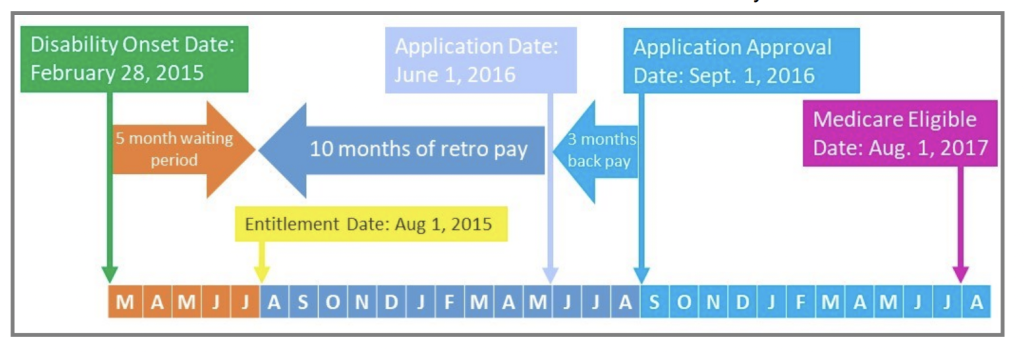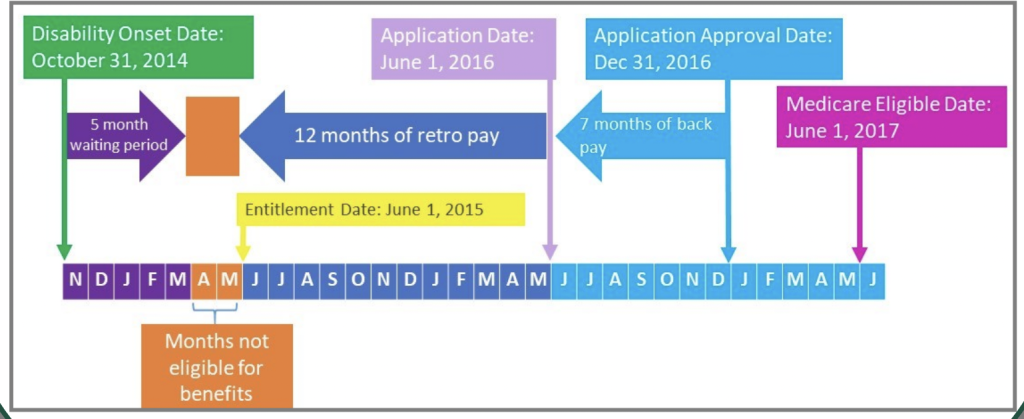Disability insurance may provide you with some income if you are unable to work because of your cancer diagnosis. Disability insurance benefits are offered by the federal government, some state governments, or through a private insurance company. For more information about the types of disability insurance, read our Quick Guide to Disability Insurance.
For more information about taking time off work and disability insurance, visit CancerFinances.org and watch our webinar on Disability Insurance.
Social Security Disability Insurance (SSDI) and Supplemental Security Income (SSI) are the two federal long-term disability programs administered by the Social Security Administration (SSA). To qualify for SSDI benefits you must have worked long enough and have paid Social Security retirement taxes. If you are eligible for SSDI benefits, the amount you will get paid each month is based on how much you have paid into the SSA retirement system over your work history.
Approximately 65% of disability applications are initially denied, so it is important to pursue the appeals process. The average wait time for an appeals decision is 600 days. But it is worth appealing, because if approved, you may be entitled to back payments and retroactive payments, even if you have returned to work by the time SSA makes a decision on your application for disability benefits.
Waiting Period: One challenge with SSDI, is that there is a 5-month waiting period from the date your disability began, before you can start receiving SSDI cash payments. According to SSA, the date that your disability begins is the date that you are no longer able to work because of your medical condition, which is typically not the date of diagnosis. It is more commonly the date that treatment starts or when you start experiencing side effects from treatment.
Back Payments: SSA knows that the application process can take a long time, so it does allow for back payments of SSDI benefits to the date of application.
Retroactive Payments: SSA also allows up to 12 months of retroactive payments from the date of application back to the date that the disability began – excluding the 5-month waiting period.
So, for someone who is just realizing that they can apply for SSDI, but their disability began 18 months ago, they could get up to 12 months of retroactive payments as well as back payments for the time it takes their application to be approved.
Medicare Coverage: In addition to SSDI cash benefits, you will automatically receive health insurance coverage through Medicare after you have received SSDI benefits for 2 full years. For information about Medicare, read our Extended Quick Guide to Medicare.
Examples to Explain the Timing of Benefits
Example #1: Mark
- Mark applied for SSDI benefits on 6/1/16
- SSA approved Mark’s application on 9/1/16 and found that his disability began on 2/28/15
- His 5-month waiting period runs from 3/1/15 through 7/31/15, which makes his entitlement date 8/1/15
- Is he entitled to back pay? Yes, 3 months from the date of his application to its approval
- Is he entitled to retroactive pay? Yes, 10 months from the date of application to his entitlement date
- He becomes eligible for Medicare on 8/1/17, 24 full months after his SSDI entitlement date

Example #2: Mary
- Mary applied for SSDI benefits on 6/1/16
- SSA approved her application on 12/31/16 and determined that her disability began on 10/31/14
- Her 5-month waiting period runs from 11/1/14 to 3/31/15, which makes her entitlement date 6/1/15 (12 months before her application date). Even though her disability began before 6/1/15, she can only get retroactive payments for a maximum of 12 months
- This leaves her with 2 months where she had a disability but was not entitled to benefits
- Mary will also receive 7 months of back payments, from 6/1/16 when she applied, to 12/31/16 when the application was approved
- She becomes eligible for Medicare on 6/1/17, 24 full months after her SSDI entitlement date

Learn More
For more information see our Disability Insurance Materials & Resources, and visit CancerFinances.org.
Sharing Our Quick Guides
We're glad you found this resource helpful! Please feel free to share this resource with your communities or to post a link on your organization's website. If you are a health care professional, we provide free, bulk copies of many of our resources. To make a request, visit TriageHealth.org/MaterialRequest.
However, this content may not be reproduced, in whole or in part, without the express permission of Triage Cancer. Please email us at TriageHealth@TriageCancer.org to request permission.
Last reviewed for updates: 01/2022
Disclaimer: This handout is intended to provide general information on the topics presented. It is provided with the understanding that Triage Cancer is not engaged in rendering any legal, medical, or professional services by its publication or distribution. Although this content was reviewed by a professional, it should not be used as a substitute for professional services. © Triage Cancer 2023

